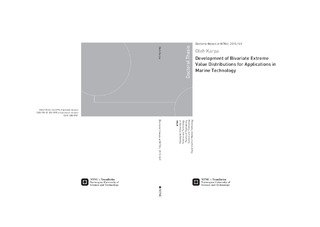| dc.description.abstract | The extreme value theory for applications in such a responsible branch of industry
as offshore and maritime engineering requires a robust, straightforward and reliable
method for estimating the statistics of extremes. A method must be able to
extract as much statistical information as possible from a recorded time series of
data. In addition, a method must be capable to utilize the information regarding
the temporal dependence structure of the process, as well as spatial dependence
characteristics of the given time series in the bivariate case.
In this thesis, a newly developed method for the purpose of predicting extremes
associated with the observed process is studied thoroughly and improved. The
method is referred to as the average conditional exceedance rate (ACER) method.
It avoids the problem of having to decluster the data to ensure independence,
which is a requisite component in the application of, for example, the standard
peaks-over-threshold (POT) method. Moreover, the ACER method is specifically
designed to account for statistical dependence between the sampled data points
in a precise manner. The proposed method also targets the use of sub-asymptotic
data to improve prediction accuracy. The research shows that the ACER method,
if properly implemented, is able to provide a statistical representation with error
bounds of the exact extreme value distribution given by the data. In the first
part of the thesis, the method is demonstrated in detail by application to both
synthetic and real environmental data. From a practical point of view, it appears to
perform better than the POT and block maxima methods, and, with an appropriate
modification, it is directly applicable to non-stationary time series.
In the second part of the thesis, the ACER method for estimation of extreme
value statistics is extended in a natural way to also cover the case of bivariate time
series. This is achieved by introducing a cascade of conditioning approximations
to the exact bivariate extreme value distribution. The results show that when the
cascade converges, an accurate empirical estimate of the extreme value distribution
can be obtained. It is also revealed that the possible functional representation of the
empirically estimated bivariate ACER surface can be derived from the properties
of the extreme-value copula.
In this thesis, application of the bivariate ACER method is substantially studied
for bivariate synthetic data. Finally, performance of the method is demonstrated
for measured coupled wind speed and wave height data as well as simultaneous
wind speed measurements from two separate locations. | nb_NO |
